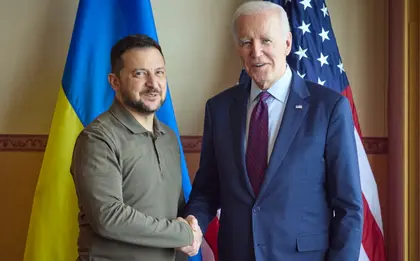A further package of $375 million in US military aid for Ukraine, including “armored bridging systems,” was announced following a meeting between American President Joe Biden and Ukrainian President Volodymyr Zelensky at the G7 Summit in Japan on the weekend.
This tranche is the Biden Administration's 38th “drawdown of equipment” from its Department of Defense inventories for Ukraine since August 2021.
JOIN US ON TELEGRAM
Follow our coverage of the war on the @Kyivpost_official.
It includes additional ammunition for US-provided HIMARS, artillery rounds for 155mm Howitzer batteries, additional anti-tank capabilities, such as Javelin systems, and armored vehicle-launched bridges (AVLBs).
An AVLBs job is to allow tank or infantry units to cross craters, anti-tank ditches, blown bridges, railroad cuts, canals, rivers and ravines. They first appeared in US announcements of military aid to Ukraine in March.
AVLBs could be a useful part of Ukraine’s upcoming counteroffensive against Russian-occupied territories. This is especially given the significant degree to which Russian forces have been establishing defensive trenches, fortifications and obstacles, including on western Crimean beachfronts, and on potential offensive routes toward Melitopol and Mariupol, as revealed yesterday by a BBC analysis of satellite images.
Craig Hooper, a security analyst, recently wrote in Forbes that “bridging units are really some of the last few pieces Ukraine requires to take the offensive.”

Ukraine Must Win, Regain Full Territory: Germany’s Merz
“The fact that they are getting donated now can only be interpreted as a sign that American experts feel confident that Ukraine is finally ready to employ their new, highly mobile equipment effectively, at scale, and in large offensive operations,” Hooper wrote.
While the number or type of AVLBs has not been made public, they are could be converted M-60 tanks where the turret and cannon has been switched out for a hydraulically-deployed, unfolding bridge. The US Marines are currently upgrading from their 50 or so AVLBs based on M-60s to one based on Abrams M1s.
An AVLB’s scissor bridge layer unfolds and provides a ready-made span across an obstacle in only minutes. Once the span is in place, the AVLB vehicle detaches from it and moves aside to allow traffic to pass.
Once all vehicles or troops have crossed, the AVLB vehicle crosses the span itself and reattaches to the span on the other side. It then retracts the span and is ready to move off.
To date, the US has committed $38 billion in security assistance to Ukraine since the beginning of the Biden Administration, including more than $37.3 billion since the beginning of Russia’s full-scale invasion on February 24, 2022.
The package announced at the G7 adds to previous similar aid including:
· 38 High Mobility Artillery Rocket Systems (HIMARS);
· Over 10,000 Javelin anti-tank systems;
· Over 160 155mm Howitzer artillery guns capable of firing rounds up to 40 kilometers, and;
· Over 2 million 155mm artillery rounds.
According to the Kiel Institute’s Ukraine Support Tracker, the US ranks first in the world in military assistance provided to Ukraine.
Since December, much of that assistance has primarily come through the Congressionally-approved the $48 billion Ukraine Security Assistance Initiative. Politico reported earlier this month that the Initiative has approximately $4 billion left.
In its coverage, Politico cited “one congressional aide who closely tracks the issue [who] estimated that, based on the rate of announcements, the money to draw down existing US stockpiles will expire in July. That would mean the flow of equipment could be disrupted if Kyiv has to wait an extended period for a new tranche of funding.”
You can also highlight the text and press Ctrl + Enter










